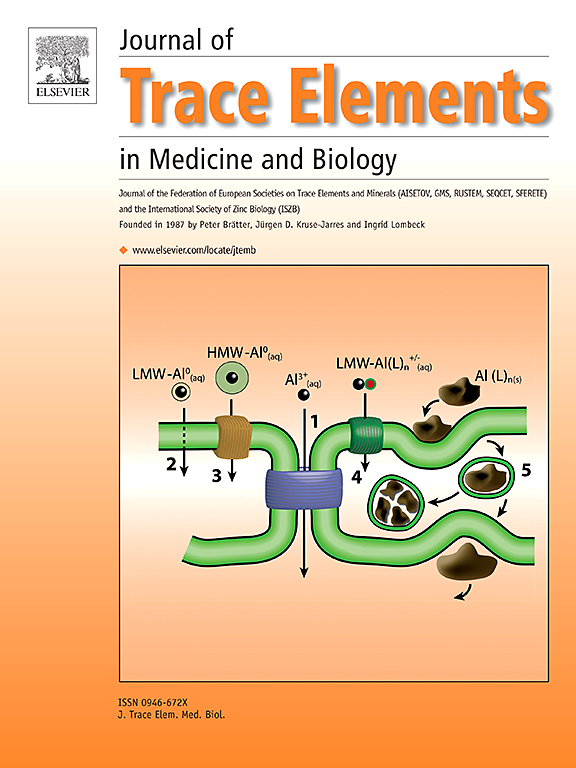育龄妇女缺铁和缺铁性贫血:性别和基于性别的风险因素和不平等
IF 3.6
3区 医学
Q2 BIOCHEMISTRY & MOLECULAR BIOLOGY
Journal of Trace Elements in Medicine and Biology
Pub Date : 2025-06-18
DOI:10.1016/j.jtemb.2025.127684
引用次数: 0
摘要
缺铁(ID)是一个严重的公共卫生问题,影响着全世界20 - 25% %的人口和52% %的孕妇。生理上的女性育龄妇女(女性)由于生理上对铁的需求增加,需要支持月经和怀孕,因此患缺铁性贫血的风险更高。如果不及时治疗,缺铁可发展为缺铁性贫血(IDA),全世界15-49岁的女性中有三分之一患有缺铁性贫血。在育龄妇女中,孕妇患缺铁和缺铁的风险最高,因为她们需要更多的铁来支持妊娠和胎儿发育。尽管ID和IDA的患病率很高,但在育龄妇女中仍未得到充分诊断,目前的治疗方案并未得到很好的接受。迫切需要研究新的战略,以确保育龄妇女有足够的铁状态,以防止不利的健康问题和促进健康怀孕。这篇综述探讨了铁在女性健康中的关键作用,通过检查整个生命周期的铁需求、铁吸收的生理学、影响铁生物利用度的因素以及缺铁和缺铁的原因。我们讨论了目前干预措施的局限性,以及对这些疾病,特别是育龄妇女开发有效和广泛接受的治疗方法的必要性。本综述的结果表明,目前对ID和IDA的干预措施是不充分的,并且在生物学上为女性的ID和IDA的诊断和管理中存在性别偏见。本文章由计算机程序翻译,如有差异,请以英文原文为准。
Iron deficiency and iron deficiency anaemia in women of reproductive age: Sex- and gender-based risk factors and inequities
Iron deficiency (ID) is a serious public health problem that affects 20–25 % of the population and 52 % of pregnant people worldwide. Biologically female women (women) of reproductive age have a higher risk of developing ID due to the increased physiologic demand for iron required to support menstruation and pregnancy. If left untreated, ID can develop into iron deficiency anaemia (IDA), which affects one in three women between the ages of 15–49 years worldwide. Among women of reproductive age, those who are pregnant have the highest risk of developing ID and IDA due to increased iron requirements to support pregnancy and the developing fetus. Despite the high prevalence of ID and IDA, it remains underdiagnosed in reproductive-aged women and current treatment options are not well accepted. There is an urgent need to investigate novel strategies to ensure adequate iron status in women of reproductive age to prevent adverse health problems and promote healthy pregnancies. This review explored the critical role of iron in women's health by examining iron requirements throughout the lifespan, the physiology of iron absorption, factors affecting iron bioavailability, and the causes of ID and IDA. We discuss the limitations of current interventions for ID and IDA, and the need to develop effective and widely acceptable treatments for these conditions, particularly in women of reproductive age. The findings of this review suggest that current interventions for ID and IDA are inadequate and that sex biases exist in the diagnosis and management of ID and IDA in biologically female women.
求助全文
通过发布文献求助,成功后即可免费获取论文全文。
去求助
来源期刊
CiteScore
6.60
自引率
2.90%
发文量
202
审稿时长
85 days
期刊介绍:
The journal provides the reader with a thorough description of theoretical and applied aspects of trace elements in medicine and biology and is devoted to the advancement of scientific knowledge about trace elements and trace element species. Trace elements play essential roles in the maintenance of physiological processes. During the last decades there has been a great deal of scientific investigation about the function and binding of trace elements. The Journal of Trace Elements in Medicine and Biology focuses on the description and dissemination of scientific results concerning the role of trace elements with respect to their mode of action in health and disease and nutritional importance. Progress in the knowledge of the biological role of trace elements depends, however, on advances in trace elements chemistry. Thus the Journal of Trace Elements in Medicine and Biology will include only those papers that base their results on proven analytical methods.
Also, we only publish those articles in which the quality assurance regarding the execution of experiments and achievement of results is guaranteed.

 求助内容:
求助内容: 应助结果提醒方式:
应助结果提醒方式:


